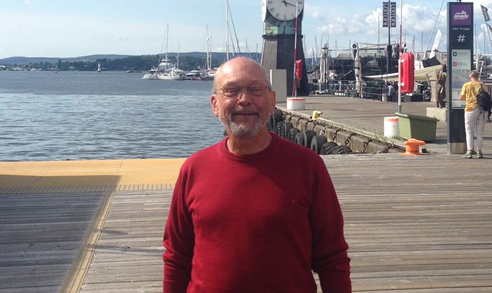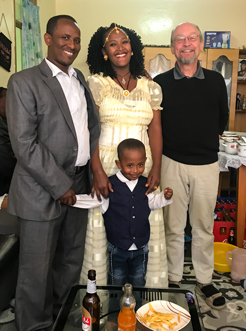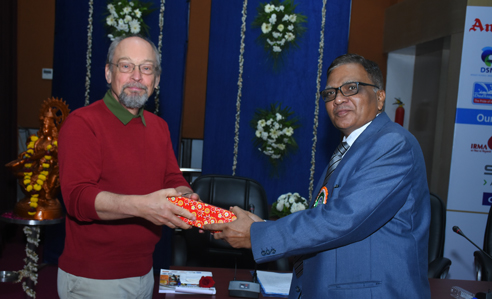Milk is eminently changeable – Richard Ipsen becomes professor emeritus
Richard Ipsen is professor of food structure engineering, with focus on dairy technology, at the Department of Food Science at the University of Copenhagen, and from 1 June – after 43 years in the service of milk – he will become a professor emeritus. In this interview, he talks about the past and future of dairy research, the Dairy Science and Technology programme and the complexity of milk. It’s this complexity that allows it to be transformed into a myriad of products.

“I have always found milk to be deeply fascinating. After all, it is originally a product intended for neonates, making adult humans unique among mammals in that we still drink milk. That we have adapted to make use of this resource is one of the factors that has helped us to survive through the ages,” stated Richard Ipsen.
He started studying biochemistry at the University of Copenhagen in 1974, but after a few years, he decided to study something with a more concrete applicability, so in 1977, he switched to the Department of Dairy Technology at the Royal Veterinary and Agricultural University (which merged with the University of Copenhagen in 2007). In the 1970s, dairy products were developing rapidly – yoghurt had come to Denmark in the 1960s, and since then a steady stream of different fermented milk products have appeared on the market.
“The unique thing about milk from a food science perspective is that you can do much more with it than you typically can with most other raw materials,” explained Richard Ipsen, who throughout his working life has studied milk mainly at the molecular level while attempting to use its components in novel ways.
However, in 1982, after completing the Dairy Technology programme, he first had to perform his military service with the civil defence unit on Bornholm. He then travelled to Kenya, where he worked for a few years training teachers from all over English-speaking Africa about dairy technology. After returning home in the mid-1980s, he was initially employed as a researcher at the Danish Government Research Institute for the Dairy Industry in Hillerød. This organization supported dairies, which numbered far more then than today. However, food research in Denmark was undergoing restructuring and when the Government Research Institute for the Dairy Industry in Hillerød closed, Richard Ipsen moved on to the Danish Meat Trade College. He led the Department of Product and Food Technology, which trained food technologists.
“I was there only for a year and a half, but it was an experience that I am thankful for, as it gave me an insight into teaching at the vocational level in the technical colleges. Plus, I got to know the meat industry and also gained some management skills that I was later able to use at the university,” he explained.
Richard Ipsen wanted to return to research and became an associate professor at the Royal Veterinary and Agricultural University (KVL) in August 1991.
The complexity of milk
For most of his working life since then, he has studied how to manipulate the basic building blocks or ingredients stemming from milk and thus, better utilise its different components. Although milk from different animals is superficially similar, even small differences can be very important in food production.
“I have for example researched camel milk, which has many similarities to cow’s milk, but there are still minor compositional differences that have a major impact on the processes when you make dairy products ,” continued Richard Ipsen, whose work on making camel milk cheese has helped to develop the teaching and research programmes in dairy technology at Haramaya University in Ethiopia.

Richard Ipsen with Ethiopian PhD candidate Tesfamariam Berhe and his family after a successful PhD defence.
One of the challenges in Ethiopia is that there were no processes for making products from camel milk, which is often simply consumed raw and untreated, immediately after the camel is milked. Products like cheese have a longer shelf life. Thus, there is the possibility of establishing a production system that can supply the domestic market and create employment. The products could even be exported, as camel milk is highly sought after in a number of countries.
However, camel milk cannot be made into cheese with the same techniques used for cow’s milk. It does not form proper cheese curd, and the structure and consistency are all wrong. The research has now led to new technologies, which have made it possible to make cheese with a texture like feta. The project has trained two PhDs and ten graduate students and has generated a great deal of interest locally. A few small dairies in Ethiopia make pasteurised milk for the local market and they are very interested in expanding their range based on the research, which was carried out in collaboration with DTU. Researchers there, at DTU, are currently investigating whether camel milk can be used for infants who are allergic to cow’s milk.
Looking to India for the future of milk
In light of the on-going climate change debate, the sustainability of milk has been challenged and there is an increasing focus on plant-based foods.
“This is something that the industry takes very seriously and we have, for example, already seen the first climate-neutral milk appear on the market. Milk is a rewarding raw material to work with. Using modern techniques, we can divide this liquid into its various components. We can isolate single proteins and manipulate its composition. In contrast, we do not yet have that level of understanding of plant proteins, which are structured in a completely different way and also require quite a bit of resource-intensive processing before they can be used. So, I certainly still see milk as a valuable element in our diet,” stated Richard Ipsen.
Historically, the food industry in Denmark has worked with milk for as long as the industry has existed. Microalgae are seen as one of the sustainable foods of the future, but the processing technology is far less well developed.
“In terms of extracting and understanding the building blocks of plants, for some plants we are in the same place as we were 100 years ago in the dairy sector, when the centrifuge was invented. That made is possible to separate the skimmed milk from the milk fat, so farmers organised themselves into cooperative societies to take advantage of the new techniques. However, we will not see a similar development in the plant sector, as it is often the larger companies that are producing plant-based ingredients for food,” continued Richard Ipsen.
He believes that in the future there will be a market for products containing a mix of cow’s milk and plant proteins. He has researched blends of milk and rapeseed protein and he believes that we must look outwards for inspiration.
“I have travelled a lot in India in recent years. They have both a historical tradition of dairy production and a vegetarian culture. There is also a long tradition for making products based on mixtures of milk and cereals or legumes, whereas in Western Europe, we have kept dairy products separate. I see a lot of potential for mixing milk with plants in the future, with inspiration from India,” explained Richard Ipsen.

Signing the collaboration agreement with the Indian university, Mansinhbhai Institute of Dairy and Food Technology.
“Another thing we can learn from India is how to use dairy products as a substitute for meat, for example, in a dinner dish. The Indian product paneer is made by simultaneously heating and acidifying milk, with citric acid, for example. Paneer can withstand being cooked or fried without losing its pleasant elastic structure. My colleague professor Lilia Ahrné has just started a project, which I will be a slightly involved in, to understand paneer. This will form the basis for exploring how dairy products can be better used as meat substitutes. The project is supported by the Danish Dairy Research Foundation, and Indian researchers are also involved.”
Focus on dairy has aided the industry
Over the years, Richard Ipsen has been closely associated with the Dairy Science and Technology programme, including as a member of the programme’s dairy contact committee and as a teacher and supervisor. He deserves a good deal of the credit for the continued existence of the programme and this is also something where he strongly commends the industry.
“Many places in the world have food programmes at university level but they don’t have a special focus on dairy. We have preserved that in Denmark, which would not have been possible without major and continuous support from the industry,” he noted.
The programme has become more global in Richard Ipsen’s time. In 2003, he was among the teachers who promoted and implemented the programme taught in English.
“We have endeavoured to analyse what’s happening in international markets and companies so that we can encompass the huge global diversity found in dairy products and dairy technology. It has, therefore, been important for me to get out into the world to see what is being produced and what products are on the shelves. Such global aspects are very important elements to incorporate into the teaching,” he stated.
Richard Ipsen has supervised the theses and bachelor projects of more 150 students, most in collaboration with industry.
“Such collaborations have been central to our programme and it shows that our students are also very interested in working with issues that can benefit the industry. They are incredibly important and a part of my work that I have been very happy with.”
The Dairy Science and Technology programme is very important for Denmark, not only by training highly qualified employees for the dairy sector, but also because the country produces so many food ingredients and so much equipment for the global dairy industry. Graduates with the specialization in Dairy Science and Technology typically find employment in the industry as managers and middle managers because they have an overview of both production and development. They know a lot about the composition of milk, and about dairy technology and microbiology, but above all they are able to grasp and understand the complexity of a modern processing line in the food industry.
Future research
When it comes to research, Richard Ipsen also welcomes close contacts with industry.
“I think the dialogue with the industry is absolutely crucial for us, since it means we do both interesting and relevant research. Some of our research, however, must be more fundamental and aimed at creating a deeper understanding, so of course not all food research should be directly applicable. However, I am glad I have been able to provide the industry with tools that can be used to ensure better products,” he stated.
Overall, Richard Ipsen is very pleased with the developments in his professional life.
“For example, we have become better at controlling the consistency of fermented milk products and investigating how the processing conditions and thus, the processing of the various dairy products affects the absorption of nutrients in the body. However, there are still major research opportunities and challenges within this area, which I think is incredibly exciting. The same goes for milk in relation to the current discoveries about the intestinal microbiome that are been made right now,” Richard Ipsen explained.

On a mule in the Simien Mountains of Ethiopia.
As professor emeritus, these tasks are still part of the future, but there are also a number of exciting possibilities at home. Richard Ipsen expects to have more time to spend on a number of interests he has cultivated over the years, including writing short stories in the fantastic genres. Recently, he has been publishing one or two short stories a year, but if the inspiration comes, there could be many more.
“Basically, I want to spend more time on my personal interests and I hope to have a little more time for reflection. In addition, I am looking forward to having more time with my family, including my grandchildren,” stated Richard Ipsen, who lives in Vanløse and is married to Ulla Madsen, a sign language interpreter who will retire soon.
Together, the couple have two adult sons and five grandchildren, who in the near future will have an even more present grandfather who probably cannot help telling them a few things about the infinite mysteries inherent in milk , as well as the amazing flavours, consistencies and forms it can take.
Topics
Related News
Contact
Communications officer at the Department of Food Science at the University of Copenhagen (UCPH FOOD) Lene Hundborg Koss, lene.h.koss@food.ku.dk
Part of the global food culture
We eat a multitude of milk-based products or milk derived ingredients that have completely different structures:
Many different kinds of milk:
Organic, conventional, biodynamic, pasteurised, UHT and with various fat percentages. We have milk that is suitable for the foam on coffee, milk that is good for people with insomnia, milk only from Jersey cows, milk only with a genetic variant of beta-casein (A2), milk with added cocoa or coffee etc. etc.
Many different cheeses:
Soft, semi-hard, hard, with or without mould, stored for years, weeks or not at all, with or without holes, with vegetable fat, good for melting etc.
Lots of acidified products:
Yoghurt, skýr, créme fraiche, junket, buttermilk, kefir, långfil, viili, quark, A38, acidified milk drinks etc.
Many different ingredients:
Skimmed milk powder, whole milk powder, whey powder, whey protein powder, cheese powder, milk protein powder, casein, caseinate, lactose, milk minerals, lactoferrin, beta-lactoglobulin, osteopontin, glycomacropeptide etc.
And a lot of other products:
Butter, spreads with vegetable fat, ice cream, sorbet, whipping cream, coffee cream, cooking cream, milkshakes, cheese sauce, milk-based sweets etc.
